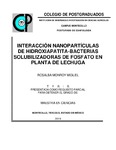| dc.description.abstract | El fósforo es el macronutrimento más importante para las plantas después del nitrógeno, sin embargo, es un recurso no renovable que al aplicarse como fertilizante fosfatado solo se aprovecha el 1 % debido a su facilidad para formar compuestos con otros elementos, por lo que el 90 % se vuelve inaccesible para los cultivos. Se prevé que para 2050 las reservas mundiales de fósforo habrán llegado a su tope máximo de producción, por lo que su deficiencia comprometerá la producción alimentaria mundial y elevará los costos de los fertilizantes fosfatados. El objetivo de esta investigación fue evaluar la interacción NPHA-BSP in vitro y posteriormente en lechuga en condiciones de invernadero, para evaluar la absorción de fósforo, como una alternativa de fertilización fosforada. La investigación se dividió en tres fases. Fase I: se realizó la selección de BSP con capacidad para solubilizar fósforo en medio NBRIP sólido y líquido, de donde se obtuvieron seis cepas bacterianas (K.oxytoca-13, K. oxytoca-21, E. cloacae-26, C. freundii-29-1, E. cloacae-31 y S. marcescens-36) con alta capacidad para solubilizar fósforo. Fase II: se evaluó la capacidad solubilizadora de fósforo de las seis cepas seleccionadas en medio NBRIP modificado con nanopartículas de hidroxiapatita (NPHA) sintetizadas por el método de precipitación química húmeda como fuente de fósforo (caracterizadas mediante TEM, DLS, DRX y FTIR). Como resultado se eligió a Enterobacter cloacae por su alta capacidad para solubilizar fósforo de distintas fuentes (64 mg L-1 y 13 mg L-1 equivalentes a 8% y 63% de P solubilizado, en RF y NPHA, respectivamente) y disminuir más el pH (4.0) de su medio. Las NPHA que se sintetizaron midieron menos de 100 nm en cualquiera de sus caras y presentaron forma de hoja, así como diámetro hidrodinámico entre 72.27 nm y 137.5 nm, se confirmó la presencia de hidroxiapatita por DRX y FTIR. Fase III: se probaron 12 tratamientos con tres fuentes diferentes de fósforo (NPHA, KH2PO4, RF), con y sin inóculo bacteriano bajo condiciones de invernadero en planta de lechuga cultivada en arena y con solución Steiner. Los resultados mostraron que el tratamiento NPHA3 casi igualó el porcentaje de fósforo total en vástago y raíz con el grupo testigo (KH2PO4) y los tratamientos con NPHA1 y NPHA2 también fueron semejantes. El inóculo bacteriano (E. cloacae-31) solo tuvo efecto significativo para volumen radical a los 95 ddg. Para estudios posteriores se recomienda cambiar las condiciones (diferente cultivo, sustrato, solución nutritiva, inoculante bacteriano, dosis y concentraciones de NPHA e inoculante bacteriano) a fin de obtener un efecto sinérgico de la interacción NPHA-BSP y optimizar los resultados. _______________ INTERACTION HYDROXYAPATITE NANOPARTICLES-PHOSPHORUS SOLUBILIZING BACTERIA IN LETTUCE PLANT. ABSTRACT: Phosphorus is the most important macronutrient for plants after nitrogen, however, it is a non-renewable resource that when applied as a phosphated fertilizer only 1% is used due to its ease in forming compounds with other elements, so that 90 % becomes inaccessible for crops. It is expected that by 2050 world phosphorus reserves will have reached their maximum production limit, so their deficiency will compromise world food production and raise the costs of phosphate fertilizers. The objective of this research was to evaluate the HANP-PSB interaction in vitro and later in lettuce under greenhouse conditions, to evaluate phosphorus absorption, as an alternative of phosphorus fertilization. The investigation was divided into three phases. Phase I: the selection of PSB was performed with the ability to solubilize phosphorus in solid and liquid NBRIP medium, from which six bacterial strains were obtained (K. oxytoca-13, K. oxytoca-21, E. cloacae-26, C. freundii -29-1, E. cloacae-31 and S. marcescens-36) with high capacity to solubilize phosphorus. Phase II: the phosphorus solubilizing capacity of the six strains selected in NBRIP medium modified with hydroxyapatite nanoparticles (HANP) synthesized by the wet chemical precipitation method as a source of phosphorus (characterized by TEM, DLS, DRX and FTIR) was evaluated. As a result, Enterobacter cloacae was chosen because of its high capacity to solubilize phosphorus from different sources (64 mg L-1 and 13 mg L-1 equivalent to 8% and 63% of solubilized P, in PR and HANP, respectively) and decrease further the pH (4.0) of its medium. The HANP that were synthesized measured less than 100 nm on any of their faces and had a leaf shape, as well as hydrodynamic diameter between 72.27 nm and 137.5 nm, the presence of hydroxyapatite was confirmed by DRX and FTIR. Phase III: 12 treatments were tested with three different sources of phosphorus (HANP, KH2PO4, PR), with and without bacterial inoculum under greenhouse conditions in a lettuce plant grown in sand and with Steiner solution. The results showed that the NPHA3 treatment almost equalized the percentage of total phosphorus in the stem and root with the control group (KH2PO4) and the treatments with NPHA1 and NPHA2 were also similar. The bacterial inoculum (E. cloacae-31) only had a significant effect for radical volume at 95 ddg. For subsequent studies it is recommended to change the conditions (different culture, substrate, nutrient solution, bacterial inoculant, doses and concentrations of HANP and bacterial inoculant) in order to obtain a synergistic effect of the HANP-PSB interaction and optimize the results. | es_MX |


